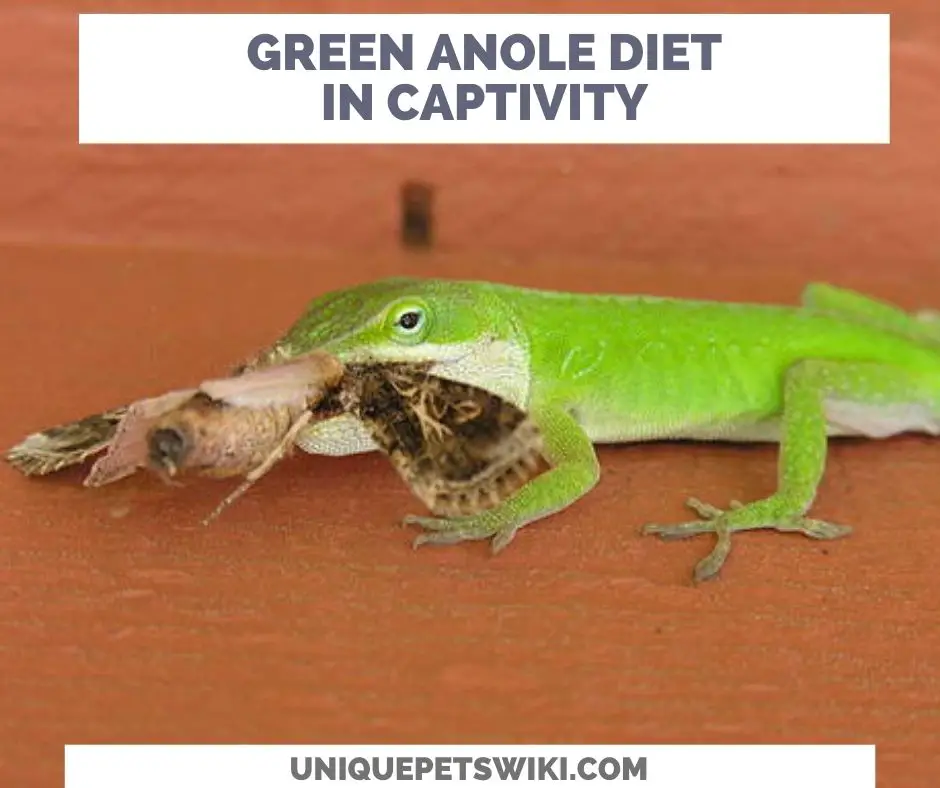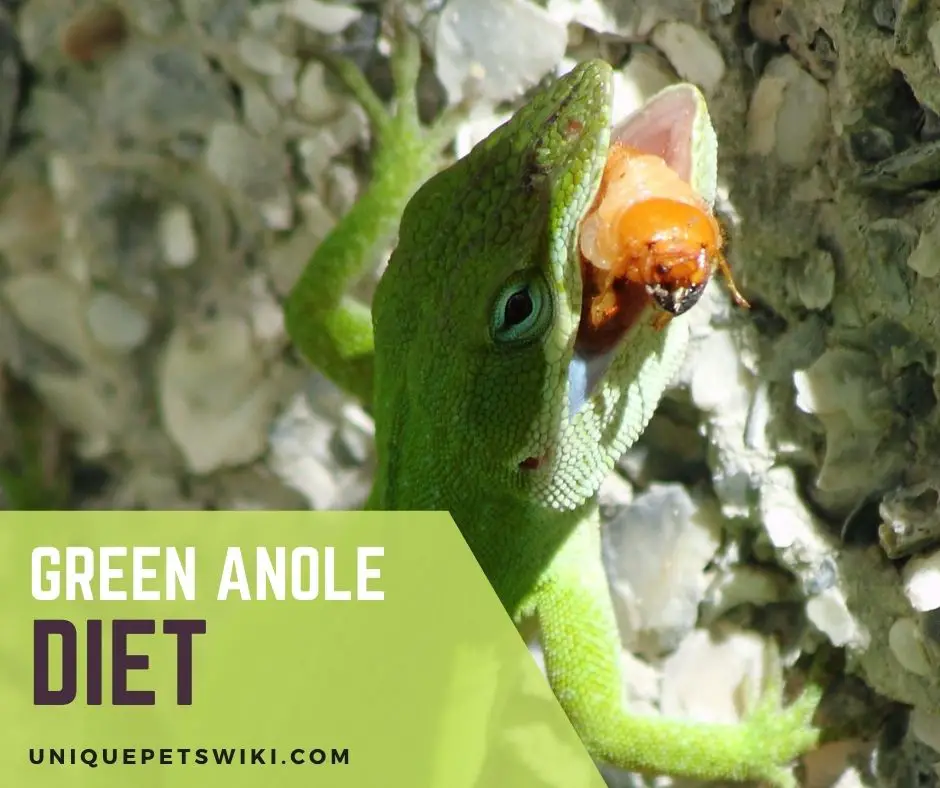Do you know green anoles love to eat whatever, especially insects or fruits you provide them with? Since they have a very unsophisticated and versatile eating style, there is the requirement of proper management of a green anole diet.
Thus, you need to know the A-Z list of foods for green anoles. Otherwise, making them eat all things can severely affect both the mental and physical health of your anoles.
In this article, I will provide you with a complete list of foods, including insects and fruits, that your green anoles can eat. In this way, you will learn what you can make your anoles eat and what you cannot.
This article has been reviewed by Dr. Dilber. Read more about our knowledge control process here.
Contents
Green Anole Diet/Food List: What Do Green Anoles Eat?
Green anoles are insectivorous and opportunistic carnivorous. Though, they eat a variety of things.
Things green anoles eat are insects, fruits, and vegetables. Green anoles eat their youngs when there is no availability of food in the habitat where they are living.
Read more: what do green anoles eat?
After rigorous research, I have compiled a list of foods that green anoles will eat and do not eat. The following are the A-Z food lists.
What Insects Can Green Anoles Eat?

Insects are the most favorite foods of green anoles. As mentioned earlier, green anoles are naturally insectivorous.
You can provide them with other things. Without insects, they cannot enjoy a day. The following list shows the variety of insects that they can eat.
- All species of ants
- Blue Bottle Flies
- Buffalo Beetles
- Dead bugs, but not preferable
- Calci Worms
- Caterpillars
- Crane Flies
- Crickets
- Cockroaches
- Earthworms
- Farm-raised maggots
- Flies
- Grasshoppers
- Kales
- Ladybugs
- Locusts
- Mealworms
- Mosquitoes
- Monarch caterpillars
- Moths
- Phoenix worms
- Pillbugs
- Dubia Roaches
- Silkworms
- Soldier Flies
- Spiders
- Snails
- Wax Moths
- Waxworms
What Fruits Can Green Anoles Eat?

You may get baffled how can the insectivorous relish on fruits? As mentioned earlier, green anoles can eat whatever is smaller than their size.
It also includes fruits that are full of nutrition, vitamin, carbohydrates. and minerals. The following is the list of fruits.
- Apples
- Bananas
- Blueberries
- Grapes
- Honeydew melons
- Oranges
- Strawberries
Do Green Anoles Eat Veggies?

In addition to fruits, green anoles love to relish on veggies. Though, fruits are not their primary diet.
You may wonder what is the good frequency to feed those veggies? It will be best if you use them as an occasional treat only.
- Carrots
- Lettuce
- Boston romaine
- Red leaf lettuces
- Iceberg lettuce And dark green lettuce.
- Leaves of plants.
- Quinoas
- Zucchini
What NOT to Feed Your Green Anoles?
The above lists are the foods that you can feed your green anoles. There are many varieties of foods that are not suitable for your anoles.
These foods can kill your anoles or make them unhealthy. To prevent any damage, you must either restrain your anoles to eat or do not provide them with the following foods.
- Any of the above foods have a larger size than your green anoles.
- Bloodworms
- Dead bugs
- Hornworms
- Kingworms
- Millipedes
- Older or larger anoles
- Stinking bugs
- Strong bugs or insects
- Super worms
- Wild insects containing both herbicides and pesticides.
What do Green Anoles Eat in the Wild?

Green anoles can eat any of the above insects, fruits, and veggies if they find. Green anoles tend to eat whatever they get in the wild.
In the wild, the availability of foods determines eating. The more abundant of a particular prey, the more the anoles predate on them. Green anoles can even eat dangerous or harmful things in the wild if they are available.
In short, the eating habits of green anoles depend on the availability of food in their habitat. If their habitat is abundant in insects and fruits, they feed on them to fulfill their requirements.
Green Anole Diet in Captivity

In captivity, the owner determines the food according to the stage and body requirements of the green anole. If green anole is weak, you need to feed them the food that has comparatively more fat content. If it is in juvenile stage, you need to offer the food that has comparatively more protein.
Even it is important to provide different things to different stages of the life of anoles. It is because their natural capability allows them to eat differently in each phase.
Adults do not need what young ones need. Thus, I have segregated the green anole diet for each stage.
| How much do green anoles eat? | How often do green anoles eat? | |
| Baby Green Anoles | small insects & leaves | 2 to 3 insects every day |
| Juvenile Green Anoles | larger crickets & leaves | 4 to 5 crickets every day |
| Adult Green Anoles | crickets, mealworms, flies, and some other insects | Every day & calcium supplements + vitamin once a week |
Baby Green Anole Diet
Baby green anoles are hungry when they come out from hatching. Thus, they can eat a variety of foods that are not larger than size of their mouth.
In other words, hatchlings prefer to munch on pinhead crickets, springtails, and flightless fruit flies. Pinhead crickets should be stapled foods for them.
In addition to these small insects, some baby anoles desperately need droplets of water from the mist of leaves rather than a handful or dish of water.
Since they are in the growth phase, they need vitamin and calcium supplements. In other words, you need to gut-load their foods with vitamin and calcium powders.
Interestingly, some baby green anoles have relished the crested gecko diet. This diet does not work unless you set the environment properly before hatching.
Juvenile Green Anole Diet
Juvenile green anoles require food that is high in energy, protein, and also a good source of fiber and adequate fat content.
The juvenile stage of green anoles reflects growth in the baby anoles. This phase requires a lot of energy to predate and get involved in other activities.
Thus, the food is vital to activate them. Juvenile anoles eat larger crickets than baby anoles.
Crickets will be stapled foods whatever phase of life they are in. Moreover, you can make them eat other insects like small flies, roaches, beetles, and other small insects.
Remember that it is a rule of thumb that anoles should eat whatever is smaller than them. Calcium and vitamin supplements are a must. In short, gut-load every insect before providing it to your juvenile anoles.
Adult Green Anole Diet
Now your green anoles have reached adulthood. In this phase of life, they will look for hunting themselves.
If you have provided your adult green anoles with a convenient environment, they will hunt in the vicinity. Be careful while they are hunting because they can swallow bigger or dangerous insects.
In addition to hunting, you can provide them with staple foods like crickets, mealworms, flies, and some other insects. You can also provide them with fruits and veggies.
Even though crickets are staple foods, gut-loading is important for vitamins and calcium. And you do not have to care about water as green anoles tend to drink through droplets from leaves.
Green Anole Feeding Schedule
You may still get baffled because you do not know how much and when to provide them with food. I have addressed your concern by letting you know in the subsequent paragraphs about dieting or feeding schedules.
The feeding schedule depends on the stage or age of the green anole. If it is young you have to feed it every day. If it is an adult, you can feed it every other day.
How Much Do Green Anoles Eat?
The general rule of thumb is that green anoles eat 3-4 insects. Remember that you must dust these insects with calcium powder regularly and provide vitamin supplements once a week.
Both baby and adult green anoles can eat 3-4 insects. As per the rule, the insects should be smaller than their size: manageable for adults and pinhead crickets for babies.
Adult Green Anole Feeding Schedule
Adult green anoles eat a lot of things from the environment through hunting. Thus, you should not overfeed them, for it can lead to problems.
You can feed adult green anoles different foods every other day. However, it is best to feed them in the daytime. Because anoles are diurnal and are active during the daytime. This is the ideal time for them to eat and get some exercise.
You should provide adult green anoles with the gut-loaded three to four insects every other or alternate day.
Like baby green anoles, you should provide adult anoles with calcium supplements with every food and multivitamin once a week.
Baby Green Anole Feeding Schedule
Unlike adult anoles, baby green anoles do not hunt. Thus, it is natural that they need more food.
Provide them with gut-loaded 2 to 3 insects every day. In this way, there are chances of growth.
What to Do If Your Green Anole Won’t Eat?
The common problem occurs when green anoles do not eat anything despite providing them with tasty, nutritious foods. Many people asked: “what to do to make them eat?”
If green anoles do not eat, it implies that they have got disease or food is larger than them. When they have impaction which results from larger insects, green anoles do not eat.
To treat this disease, you need to provide them with smaller insects and approach the vet. Remember that anoles cannot digest what is larger than them.
Even if they take them, they will likely fall prey to impaction. In addition to the disease, there are chances that you are overfeeding them.
If you regularly provide adults with crickets, waxworms, and mealworms, they will not enjoy eating because they consume a lot.
Green anoles munch on insects that move on before their eyes. They love to eat live insects.
Thus, they do not eat what is not moving. Your anoles do not eat because you may have given them dead insects.
Finally, although crickets are stapled for green anoles, they do prefer to eat various foods. You may constantly bombard with crickets.
Thus, they are not eating them. You should add various things to their diet. Apart from these things, you can follow the following things.
- Try to purchase and then use the small suction-cupped window bird feeders to make them eat comfortably.
- Use the Reptoboost which you can use for spraying the tank.
- Use Avipro sprinkling for the appetite.
Wrapping Up for Green Anole Diet
Knowing green anoles diet from A-Z is very crucial because anoles are what they eat. If they eat healthy foods, they will become strong.
On the other hand, dangerous foods will lead to problems, even death. Your anoles can eat insects, fruits, and vegetables.
After analyzing the lists, you need to provide your anoles with foods according to their phase. It is because each phase needs a different diet.
Despite such foods, if they do not eat, you will have to identify or diagnose the problems and then set them right. In this way, your anoles will be healthy, strong, and active.
